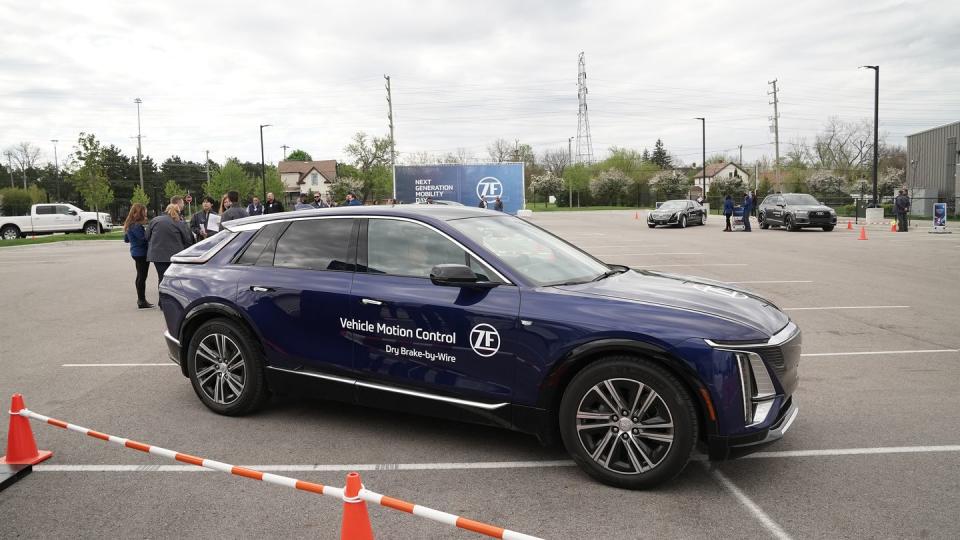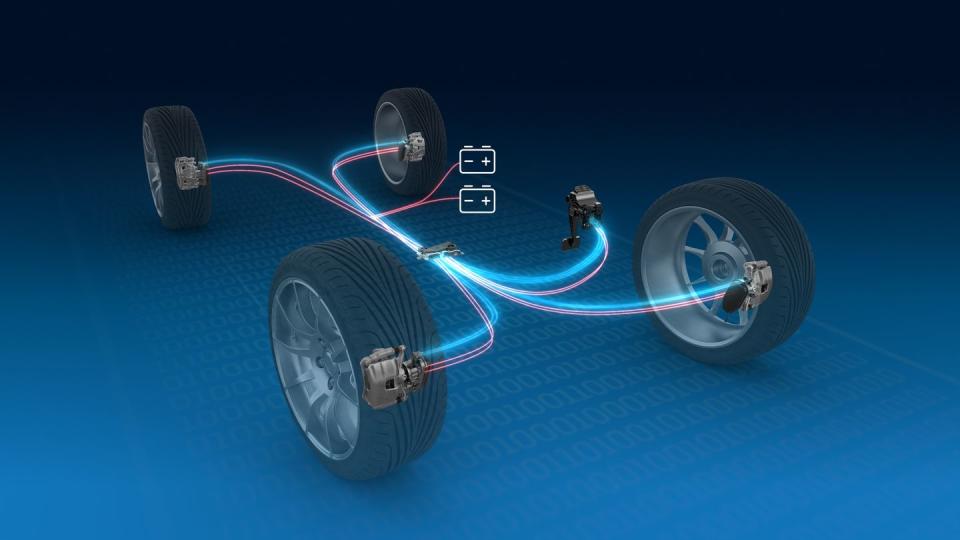Dry Brake-by-Wire Could Replace Hydraulics, ZF Says

ZF stuffed its dry brake-by-wire system into a Cadillac Lyriq mule and offered laps around a closed course.
The ZF dry brake-by-wire system replaces traditional hydraulic brakes with electric motors at the wheel to provide clamping.
This system also integrates the parking brake into the caliper and wouldn’t require a separate electric motor to engage the electronic parking brake.
“The safety of steel from pedal to wheel” was once a pushback against the dangerous nature of using hydraulic fluids to stop your car. Of course, it turns out that a simple hydraulic system can safely—and regularly—bring your multi-ton machine to a halt without breaking too much of a sweat.
You can look back and mock the mechanical brake proponents thanks to decades of hydraulic supremacy, but skepticism about the single most important system on your car is understandable.
Now, it looks like there might be another shift in braking tech on the horizon: dry brake-by-wire.
For those out of the loop, brake-by-wire systems exist in production cars. However, these production systems are technically called electro-hydraulic brake systems, which blend the packaging liberties of a brake-by-wire system with the decades of confidence and research devoted to hydraulic brake systems.
The possible next wave of braking tech could do away with that hydraulic system altogether, and bring you to a halt through the magic of electricity and software.
Despite general skepticism about getting rid of brake fluid, yours truly still hopped behind the wheel of ZF’s dry brake-by-wire Cadillac Lyriq test mule. This system isn’t a true-to-form example of ZF’s final vision for a dry brake-by-wire system, because it used Lyriq’s integrated brake controller alone but adapted it to work with the dry system.

In reality, this whole kit would use essentially the same kind of controller found on your drive-by-wire accelerator.
From that brake controller, the input signal bounces around the Lyriq’s CAN Bus network to tell the electro-mechanical brake calipers that it’s time to clamp down on a rotor. Of course, that all is easier said than done.
Sitting behind the wheel of this Lyriq test mule, with a ZF representative riding in the passenger seat explaining how the system works, we went for a lap around Michigan’s M1 Concours, a private track for car collectors. While far from a real-world test, or a brutal race session, this short stint was reassuring.
While time with the test mule was short, and the conditions were about as prime as you could get to briefly experience a novel braking configuration, the whole brake-by-wire system felt natural. There wasn’t any noticeable input lag, and it brought the Lyriq test mule to a halt. Squeezing the brake pedal felt natural, and the Lyriq mule felt just like it should.
As for pesky problems like ABS and heat management, the ZF rep had answers. Explaining the antilock brake problem, the answer is swift: “We have really fast motors.” The rep further explains that the motors inside the calipers are three-phase permanent magnet motors and can provide the quick actuation that makes antilock brakes work.
Brake temperatures also haven’t been a problem, according to the ZF rep. However, there are still some tests the company wants to perform.
Now, if you’ve made it this far, you’re still probably wondering why anyone would want to deviate from a braking system that’s had nearly a century’s worth of research, development, and testing. Well, apparently, cost.
This dry brake-by-wire system should be easier and less expensive for automakers to manufacture. Of course, there will be added costs in more expensive brake calipers, but that would be offset by a lack of traditional braking hardware like ABS modules, lines, and the like.
There’s also the reduced manufacturing step of not having to fill a braking system when the only thing powering the calipers is electrons.
As surprising as it may seem, dry brake-by-wire could be an answer to some legitimate problems—just like hydraulics were in the 1920s and 1930s. But, also like the switch to hydraulics, don’t expect this system to hit the street anytime soon.
Without any cars currently in production, it would be a handful of years before this technology would be adapted to a production-ready machine. However, the folks at ZF are actively shopping this system around to automakers, which means it could show up sooner rather than later.
Would you ever buy a car that has a dry brake-by-wire system? Tell us your thoughts below.

 Yahoo Autos
Yahoo Autos 